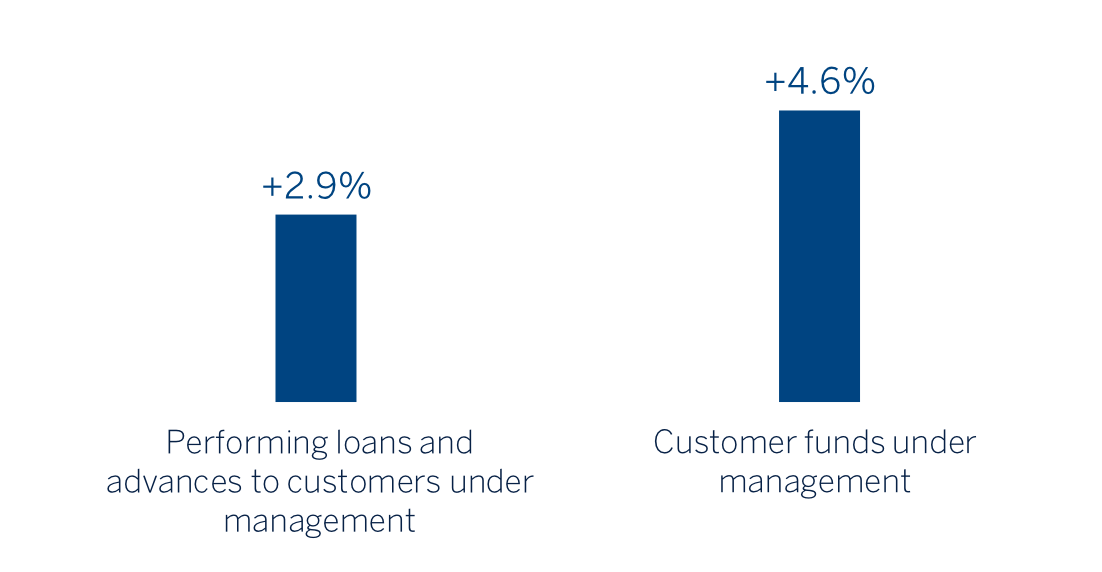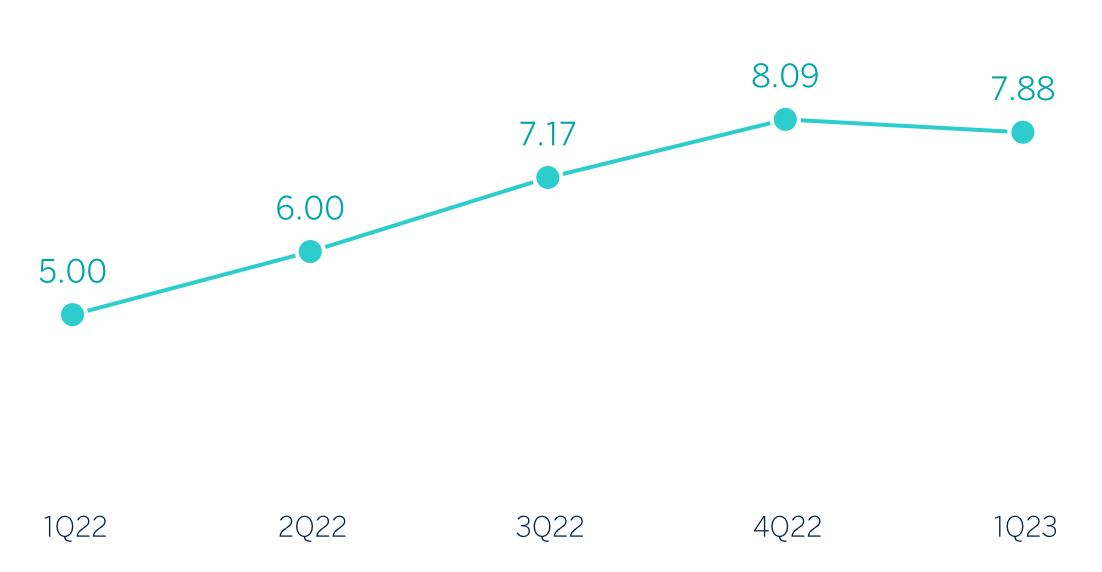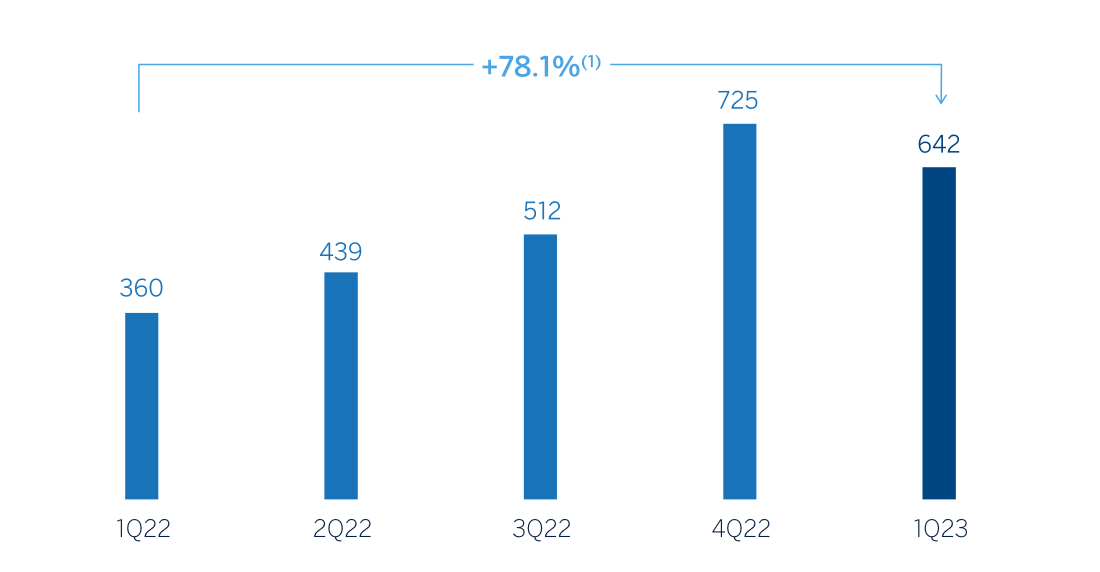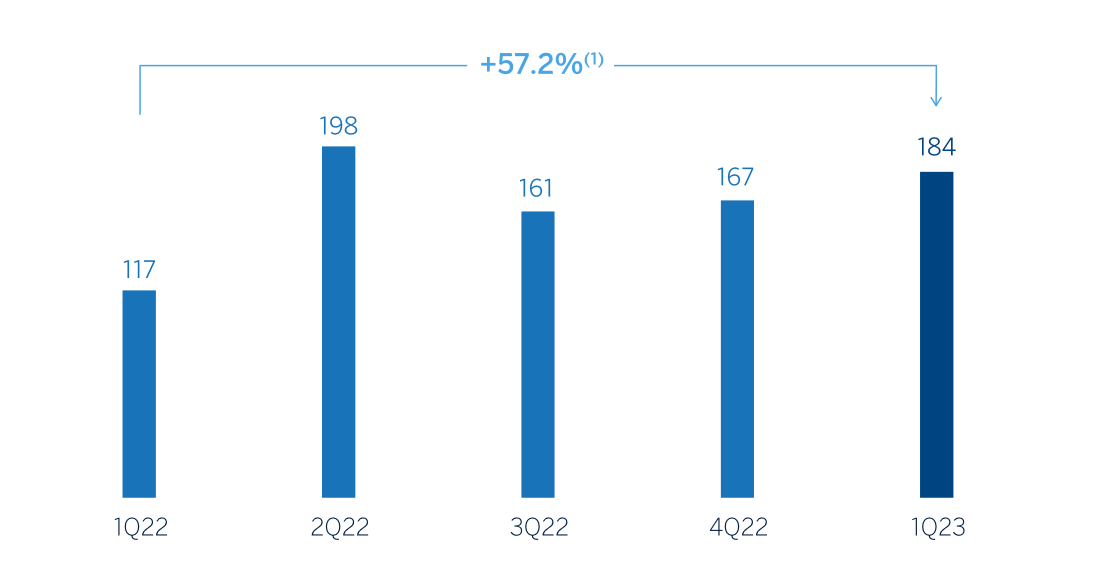South America
Highlights
- Growth in lending activity and customer funds
- Favorable performance of recurring income
- Higher adjustment for hyperinflation in Argentina
- Improvement of the efficiency ratio
Business activity (1)
(VARIATION AT CONSTANT EXCHANGE RATES COMPARED TO
31-12-22)

(1) Excluding repos.
Net interest income / AVERAGE TOTAL ASSETS
(PERCENTAGE AT CONSTANT EXCHANGE RATES)

Operating income
(Millions of euros at constant exchange rates)

(1) At current exchange rates: +35.7%.
Net attributable profit (LOSS)
(Millions of euros at constant exchange rates)

(1) At current exchange rates: +14.8%.
Financial statements and relevant business indicators (Millions of euros and percentage)
| Income statement | 1Q23 | ∆% | ∆% (1) | 1Q22 (2) |
|---|---|---|---|---|
| Net interest income | 1,190 | 47.0 | 81.7 | 809 |
| Net fees and commissions | 184 | 3.4 | 21.0 | 178 |
| Net trading income | 127 | 36.3 | 66.1 | 93 |
| Other operating income and expenses | (326) | 66.9 | 85.3 | (195) |
| Gross income | 1,175 | 32.7 | 66.1 | 885 |
| Operating expenses | (533) | 29.2 | 53.6 | (413) |
| Personnel expenses | (252) | 25.5 | 50.6 | (201) |
| Other administrative expenses | (239) | 34.4 | 61.7 | (177) |
| Depreciation | (43) | 24.0 | 32.1 | (35) |
| Operating income | 642 | 35.7 | 78.1 | 473 |
| Impairment on financial assets not measured at fair value through profit or loss | (227) | 61.2 | 98.2 | (141) |
| Provisions or reversal of provisions and other results | (9) | (45.8) | (38.5) | (16) |
| Profit (loss) before tax | 405 | 28.6 | 75.4 | 315 |
| Income tax | (124) | 38.3 | 94.8 | (89) |
| Profit (loss) for the period | 282 | 24.7 | 68.1 | 226 |
| Non-controlling interests | (98) | 48.7 | 92.9 | (66) |
| Net attributable profit (loss) | 184 | 14.8 | 57.2 | 160 |
| Balance sheets | 31-03-23 | ∆% | ∆% (1) | 31-12-22 (2) |
|---|---|---|---|---|
| Cash, cash balances at central banks and other demand deposits | 7,646 | (0.6) | 2.8 | 7,695 |
| Financial assets designated at fair value | 10,559 | (1.7) | 3.7 | 10,739 |
| Of which: Loans and advances | 61 | (59.6) | (60.4) | 152 |
| Financial assets at amortized cost | 41,734 | 3.2 | 4.4 | 40,448 |
| Of which: Loans and advances to customers | 39,185 | 1.9 | 3.0 | 38,437 |
| Tangible assets | 1,070 | (1.6) | 1.0 | 1,088 |
| Other assets | 2,054 | 3.7 | 4.4 | 1,981 |
| Total assets/liabilities and equity | 63,063 | 1.8 | 4.0 | 61,951 |
| Financial liabilities held for trading and designated at fair value through profit or loss | 2,390 | (15.1) | (16.4) | 2,813 |
| Deposits from central banks and credit institutions | 5,395 | (3.8) | (4.7) | 5,610 |
| Deposits from customers | 40,782 | 1.8 | 4.6 | 40,042 |
| Debt certificates | 3,070 | 3.9 | 3.3 | 2,956 |
| Other liabilities | 5.537 | 18.9 | 26.3 | 4,655 |
| Regulatory capital allocated | 5,889 | 0.2 | 2.4 | 5,874 |
| Relevant business indicators | 31-03-23 | ∆% | ∆% (1) | 31-12-22 |
|---|---|---|---|---|
| Performing loans and advances to customers under management (3) | 39,206 | 1.9 | 2.9 | 38,484 |
| Non-performing loans | 1,929 | 5.1 | 5.2 | 1,835 |
| Customer deposits under management (4) | 40,782 | 1.8 | 4.6 | 40,042 |
| Off-balance sheet funds (5) | 17,971 | 1.2 | 4.7 | 17,760 |
| Risk-weighted assets | 47,341 | 1.1 | 3.1 | 46,834 |
| Efficiency ratio (%) | 45.4 | 46.3 | ||
| NPL ratio (%) | 4.3 | 4.1 | ||
| NPL coverage ratio (%) | 99 | 101 | ||
| Cost of risk (%) | 2.18 | 1.69 |
(1) At constant exchange rates.
(2) Restated balances according to IFRS17 - Insurance contracts.
(3) Excluding repos.
(4) Excluding repos and including specific marketable debt securities.
(5) Includes mutual funds, customer portfolios in Colombia and Peru and pension funds.
South America. Data per country (Millions of euros)
| Operating income | Net attributable profit (loss) | |||||||
|---|---|---|---|---|---|---|---|---|
| Country | 1Q23 | ∆% | ∆% (1) | 1Q22 (2) | 1Q23 | ∆% | ∆% (1) | 1Q22 (2) |
| Argentina | 170 | 106.8 | n.s. | 82 | 52 | 181.9 | n.s. | 18 |
| Colombia | 123 | (28.9) | (17.3) | 173 | 41 | (43.3) | (34.0) | 72 |
| Peru | 258 | 37.7 | 32.0 | 187 | 57 | 12.9 | 8.2 | 51 |
| Other countries (3) | 90 | 204.5 | 179.1 | 30 | 34 | 75.5 | 63.2 | 19 |
| Total | 642 | 35.7 | 78.1 | 473 | 184 | 14.8 | 57.2 | 160 |
- (1) Figures at constant exchange rates.
- (2) Restated balances according to IFRS17 - Insurance contracts.
- (3) Bolivia, Chile (Forum), Uruguay and Venezuela. Additionally, it includes eliminations and other charges.
South America. Relevant business indicators per country (Millions of euros)
| Argentina | Colombia | Peru | ||||
|---|---|---|---|---|---|---|
| 31-03-23 | 31-12-22 | 31-03-23 | 31-12-22 | 31-03-23 | 31-12-22 | |
| Performing loans and advances to customers under management (1) (2) | 3,854 | 3,183 | 13,723 | 13,541 | 17,033 | 16,804 |
| Non-performing loans (1) | 71 | 53 | 641 | 612 | 1,074 | 1,045 |
| Customer deposits under management (1) (3) | 6,900 | 5,787 | 13,625 | 13,307 | 16,432 | 16,090 |
| Off-balance sheet funds (1) (4) | 2,313 | 1,914 | 2,417 | 2,086 | 1,447 | 1,441 |
| Risk-weighted assets | 7,910 | 8,089 | 15,450 | 15,279 | 18,460 | 17,936 |
| Efficiency ratio (%) | 54.1 | 61.3 | 46.3 | 40.4 | 37.3 | 37.2 |
| NPL ratio (%) | 1.7 | 1.6 | 4.3 | 4.2 | 5.0 | 4.9 |
| NPL coverage ratio (%) | 169 | 173 | 103 | 106 | 90 | 91 |
| Cost of risk (%) | 4.00 | 2.61 | 1.74 | 1.56 | 2.11 | 1.58 |
- (1) Figures at constant exchange rates.
- (2) Excluding repos.
- (3) Excluding repos and including specific marketable debt securities.
- (4) Includes mutual funds and customer portfolios (in Colombia and Peru).
Unless expressly stated otherwise, all the comments below on rates of change, for both activity and results, will be given at constant exchange rates. These rates, together with the changes at current exchange rates, can be found in the attached tables of the financial statements and relevant business indicators.
Activity and results
The most relevant aspects related to the area's activity during the first quarter of the year 2023 were:
- Lending activity (performing loans under management) recorded an increase of 2.9%, with growth focused on the retail portfolio, which grew more than the wholesale portfolio (+4.0% versus +1.9%), favored by the evolution of consumer loans (+4.9%) and credit cards (+10.5%).
- With regard to asset quality, the NPL ratio stood at 4.3%, with an increase of 15 basis points in the quarter at the regional level, although stable in relation to the same period of the previous year. For its part, the area's NPL coverage ratio stood at 99%.
- Customer funds under management increased (+4.6%) compared to the closing balances at the end of 2022, with higher contribution from time deposits (+15.6%) in an environment of rising benchmark rates and, to a lesser extent, on off- balance sheet funds (+4.7%).
South America generated a cumulative net attributable profit of €184m at the end of the first quarter of the year 2023, which represents a year-on-year variation of +57.2%, mainly due to the outstanding performance of recurring income (+70.3%) and NTI, which comfortably offset the growth of expenses, in a highly inflationary environment throughout the region, and the higher provisioning requirements for impairment on financial assets.
With regard to the aforementioned inflation impact in Argentina, it stood at €-241m at the end of March 2023, above the €-142m accumulated at the end of March 2022, registered in the "Other operating income and expenses" heading of the area's income statement.
More detailed information on the most representative countries of the business area is provided below:
Argentina
Macro and industry trends
Despite the less favorable global context and the local environment marked by the difficulty in fixing current macroeconomic distortions and meeting the targets set in the agreement reached with the International Monetary Fund, economic activity showed some dynamism in 2022, with GDP growing by 5.2% in the period, two tenths of a percentage point more than forecast by BBVA Research. However, the most recent data show a significant slowdown in economic activity, in addition to the strong negative impacts of the recent drought on agricultural production and exports. In this context, the forecast for GDP growth in 2023 has been cut from -0.5% three months ago to -2.5%. Moreover, the expectation of GDP contraction in 2023 is supported by the global slowdown, high inflation (94.8% in December 2023, 103,4% in March according to BBVA Research's forecast, and expected to be around 107% in 2023, on average), financial volatility, limited margin for further stimulus measures and uncertainty about the evolution of economic policy in a presidential election year.
The banking system continues to grow at a steady pace, but remains driven by high inflation. With provisional data as of March 2023, total lending grew by 78.3% compared to the same month in 2022, favored by both consumer and corporate portfolios, reaching growth of 78.0% and 86.0% year-on-year, respectively. For its part, deposits accelerated their growth compared to previous months, increasing by 110% year-on-year according to the provisional data as of March 2023. Finally, the NPL ratio remained stable at 3.21% in January 2023 (113 basic points lower than in the same month in 2022).
Activity and results
- In the first quarter of 2023, performing loans under management increased by 21.1%, a figure that is well below inflation, with growth in both the business portfolio (+22.8%) and the retail portfolio (+19.7%), highlighting in the latter credit cards (+16.0%) and consumer loans (+24.7%), the latter driven by the lending campaign to favor the financial inclusion of certain customers. The NPL ratio stood at 1.7%, which represents an increase compared to the previous year (+13 basis points) originating from retail portfolios. For its part, the NPL coverage ratio stood at 169% in the quarter due to the increase in the non-performing loans balance.
- Balance sheet funds grew by 19.2% between January and March 2023, with a similar increase of time and demand deposits, in absolute terms, although the latter increased at a faster rate (+15.3% versus +24.8%). For its part, mutual funds also performed favorably (+20.8%).
- The cumulative net attributable profit at the end of March 2023 stood at €52m, well above the figure achieved in the first quarter of 2022, mainly due to the favorable evolution of the net interest income driven by both volume and price effects, with a clear improvement in customer spread, as well as higher yields on securities portfolios. The year-on-year evolution of net fees and commissions and NTI was also favorable and was partially offset by a more negative adjustment for inflation, higher expenses -both personnel expenses due to salary revisions and general expenses- and loan-loss provisioning.
Colombia
Macro and industry trends
Economic activity slowed at the end of last year, bringing growth in 2022 to 7.5%, below BBVA Research's forecast of 8.0%. In addition, high inflation (13.1% in December and 13.3% in March) prompted the Bank of the Republic to raise interest rates to 13% in March. In this context, and taking into account financial volatility and economic policy uncertainty, BBVA Research estimates that interest rates will remain at this contractionary level, or even at a slightly higher level until the fourth quarter of this year, inflation will remain relatively high in 2023 (12.0%, on average) and that growth will decelerate significantly to around 0.7% in 2023 (unchanged from the previous forecast).
Total lending growth in the banking sector stood at 15.4% year-on-year in January 2023, and continues to be driven by corporate credit at 16.6% and lending to households, mainly consumer loans, at 16.6% year-on-year. Moreover, total deposits grew by 14.4% year-on-year at the end of January 2023, characterized by a strong shift towards time deposits (up 54.2% year-on-year) and a slowdown in the growth of demand deposits (to -1.7% year-on-year). The system's NPL ratio remained stable at around 3.93% in January 2023, a drop of 21 basis points since the same month in 2022.
Activity and results
- Lending activity registered a growth of 1.3% compared to the end of 2022. Noteworthy was the performance in the retail portfolio (+2.2%), thanks to the performance of consumer loans and credit cards, while the wholesale portfolio showed stability (+0.2%). In terms of asset quality, the NPL ratio increased in the first quarter of the year (+18 basis points) to 4.3%, originating from retail portfolios, mainly consumer portfolio. For its part, the NPL coverage ratio declined slightly in the quarter to 103%.
- In the first quarter of 2023, customer deposits increased by 2.4% thanks to the positive evolution of time deposits (+13.1%). For its part, off-balance sheet funds recorded a growth of 15.9% between January and March 2023.
- The cumulative net attributable profit at the end of the first quarter of 2023 stood at €41m, that is, 34.0% lower than at the end of the same quarter of the previous year. The lower contribution from net interest income was affected by the high cost of funds and was offset by NTI and net fees and commissions income. On the lower part of the income statement, higher operating expenses and higher provisions for impairment of financial assets.
Peru
Macro and industry trends
Against a context of political instability, which could have a negative impact on economic activity, GDP expanded by 2.7% in 2022, in line with BBVA Research's forecast. Moreover, uncertainty about future policies, high inflation, high interest rates and the global economic slowdown will negatively impact growth in 2023, a period for which growth is expected to be around 1.9%, six tenths of a percentage point below the previous forecast. Inflation, which closed 2022 at 8.5% and reached 8.4% in March, would remain high in 2023 (around 6.3%, on average), while official interest rates would remain at the current level of 7.75% in the coming months.
Total credit growth in the Peruvian banking system continued to moderate, reaching 1.8% year-on-year in February 2023. The strongest slowdown continues to be observed in corporate loans, with a balance contraction of 4.7% year-on-year. In contrast, the dynamism of consumer loans remains, with the balance growing by 22.5% year-on-year in February 2023, while the mortgage portfolio maintained a stable growth rate of around 7.3% year-on-year. The system's total deposits grew slightly (+1.6% year-on-year in February 2023), with a greater shift towards time deposits (+31.0% year-on-year) to the detriment of demand deposits (-8.8% year-on-year). The system's NPL ratio deteriorated slightly to 3.39% in February 2023 (19 basis points higher than in the same month in 2022).
Activity and results
- The quarterly variation of lending activity stood at +1.4% at the end of March 2023, with a favorable evolution of consumer loans (+5.4%) and credit cards (+7.3%) and a flat performance in the business segment (+0.8%), mainly due to the difficulty of offsetting the amortizations of the program Reactiva Peru. Apart from the above, the NPL ratio increased slightly to 5.0%, affected by NPL entries of certain SMEs and other retail portfolios. For its part, the coverage ratio stood at 90%, in line with year-end 2022.
- Customers funds under management increased by 2.0% during the first quarter of 2023, due to the favorable performance of time deposits (+17.2%), supported by the rise in benchmark rates by the central bank, which offset lower balances in demand deposits (-4.0%) and the flat performance of off-balance sheet funds (+0.4%).
- BBVA Peru's net attributable profit stood at €57m at the end of March 2023, 8.2% higher than the figure achieved at the end of the same quarter of the previous year, driven by recurring income from the banking business, which grew by 28.4%, thanks to the favorable evolution of the net interest income, which benefited from the increase in the customer spread and the higher return on the securities portfolio, and, to a lesser extent, from fees and commissions, and NTI. On the lower part of the income statement, there was an increase in operating expenses (+23.8%) and in the level of provisions for impairment of financial assets (+186.3%), mainly due to higher requirements compared to the previous year in the recurring performance of the portfolio, together with a first quarter of 2022 that included some non-recurring positive elements.
